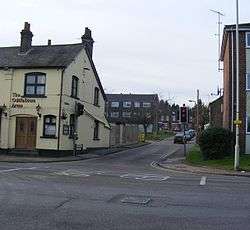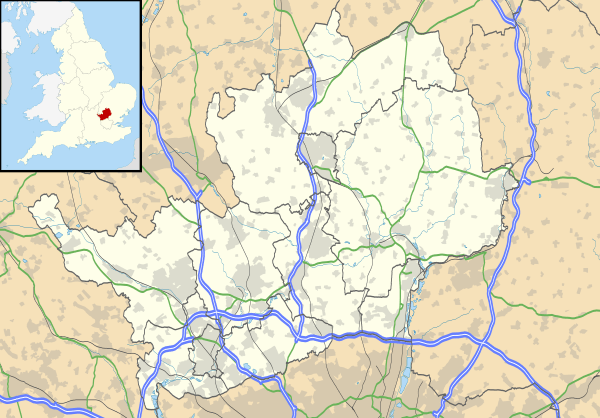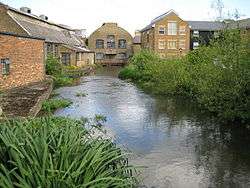Apsley, Hertfordshire
Apsley was a 19th-century mill village in the county of Hertfordshire, England. It is a historic industrial site situated in a valley of the Chiltern Hills. It is positioned below the confluence of two permanent rivers, the Gade and Bulbourne. In an area of little surface water this was an obvious site for the location of water mills serving local agriculture. Today it is a suburb of the larger town of Hemel Hempstead.
| Apsley | |
|---|---|
 Part of London Road, Apsley | |
 Apsley Location within Hertfordshire | |
| OS grid reference | TL0505 |
| District | |
| Shire county | |
| Region | |
| Country | England |
| Sovereign state | United Kingdom |
| Post town | HEMEL HEMPSTEAD |
| Postcode district | HP3 |
| Dialling code | 01442 |
| Police | Hertfordshire |
| Fire | Hertfordshire |
| Ambulance | East of England |
| UK Parliament | |
Recent (2011–) rapid building around the canal area has seen a large influx of London commuters, largely from the software and business communities. At the 2011 Census the village was included in the Dacorum Ward of Apsley and Corner Hall.
Origin of the name
The name Apsley dates from the Anglo-Saxon period and means aspen wood.
Brief history
It was the construction of the trunk canal (later to be called the Grand Union Canal) between London and the Midlands through the valley in 1798 that began its industrial rise at the start of the 19th century. The canal gave an easy way of transporting the raw and manufactured products to and from the mills.

John Dickinson, the inventor of a new method of continuous papermaking, purchased an existing mill in the area in 1809. There is record of paper making already taking place nearby at this time. His business expanded throughout the Victorian age coming to occupy large parts of the flat land in the valley bottom. Streets of mill workers' terraced houses grew up adjacent to the mills. Housing for managers was built on the old Manor Farm, higher up the hill towards Felden, in the grounds of the Manor Estate, today known as Shendish Manor. Production peaked during the Second World War. The site was however not ideal for large scale papermaking in the 20th century and later became a warehouse and distribution centre for products made elsewhere. The last John Dickinson warehouse closed in 1999. Frogmore Paper Mill is a working paper mill and visitor centre located in some of the original mill buildings.[1] Paper continued to be made until 2006 a short distance away at Nash Mills by the global Sappi group at a former John Dickinson mill. This too closed for production in 2006 but continued as a distribution centre for some time.[2] In 2011, the Sappi site was redeveloped for canal-side housing, preserving some of the historic structures at the site.
In the 1950s the adjacent town of Hemel Hempstead was designated a New Town as part of the provision of new residential areas surrounding London and Apsley became a part of the development, also giving its name to the new school of Apsley Grammar School at Bennetts End.
Apsley today
Today, Apsley is an outer district of Hemel Hempstead and is still a busy commercial centre. The Victorian shops that grew up when it was a mill town now house newsagents, public houses, restaurants, and a range of small businesses. The former mill sites are taken up with supermarkets, retail parks and offices (including large offices on the Dolittle Meadows site occupied by Hertfordshire County Council, Epson, HSBC and until recently, British Telecom). Housing developments combining the canal-side location with the ease of access to Apsley railway station have been very successful, and Apsley Marina is a thriving location for boaters.
The local parish church is St Mary's, in London Road. There is also a Methodist church.
An important local issue since the summer of 2003 is the proposal to build on land surrounding the Manor Estate in Apsley that had previously been designated as green belt land. A new housing estate, called the Aspen Estate, has since been built on the hills above the Manor Estate.
Apsley timeline
- 13th century – Ralf de Chenduit was granted land in the area. The local manor is still called Shendish Manor today.
- 1803 – First record of paper making in the area at nearby Frogmore.
- 1809 – John Dickinson, the inventor of a continuous mechanised papermaking process, purchased a corn mill in the valley and started making paper.
- 1811 – The Grand Junction Canal, later to be called the Grand Union Canal, opened to through traffic. The original route of part of the canal was higher up the side of the valley passing north of the George and the Three Tuns pubs on Belswains Lane. It put Apsley on the principal trade route from London to the north.
- 1836 – John Dickinson built his country house in nearby Nash Mills and called it Abbot's Hill. It is now a private school.
- 1838 – The London and Birmingham Railway passed through the valley adjacent to the site but no station was built. Canals continued to be the primary commercial means of transport for Apsley's mills.
- 1853 – Charles Longman, heir to the publisher Longman's and partner to John Dickinson, bought the Shendish estate and built an impressive manor house.
- 1871 – The Church at Apsley End was opened for public worship; its construction was funded by Charles Longman.
- 1938 – Apsley railway station was built with backing from John Dickinson Ltd as a way to bring more people to work at the mills.
- 1939–1945 – John Dickinson's was at its peak, and employed more than 7,000 workers. It made munitions as well as paper and paper products.
- 1999 – The last paper mills owned by John Dickinson were finally shut.
- 2003 – A national paper museum was built to celebrate the links between the industry and the town.
- 2006 - Apsley Marina was established.
- 2011 – Local Football Club Apsley Athletic FC was formed.
See also
- Apsley House, London, which has no connection with Apsley in Hertfordshire but takes its name from its first owner Baron Apsley, the 2nd Earl Bathurst. His title refers to Apsley, Sussex where the Bathurst family had connections. The present holder of the Earldom Bathurst is Allen Christopher Bertram Bathurst, 9th Earl Bathurst, whose son and heir uses the secondary title of Lord Apsley.
References
A Hertfordshire Valley by Scott Hastie photographs by David Spain, Alpine Press Ltd, Kings Langley, 1996, ISBN 0-9528631-0-3
- "Frogmore Paper Mill". Visit Southeast England. Retrieved 5 September 2018.
- http://www.hemelhempsteadtoday.co.uk/ViewArticle2.aspx?SectionID=841&ArticleID=1415761 hemelhempsteadtoday.co.uk
External links
- Apsley (A Guide to Old Hertfordshire)
- Official Website of The Paper Trail project
- Information on The National Paper Museum Project
- Apsley Local History and pictures from Hemelonline
- Shendish Manor today with its history
- Manor Estate Residents' Association and their battle to prevent development on green-belt land in Apsley
- Official Website of Apsley Marina
- Historic England. "St Mary's Church, Apsley (1067764)". National Heritage List for England.